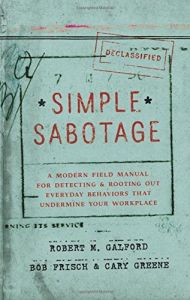Join getAbstract to access the summary!

Join getAbstract to access the summary!
Robert M. Galford, Bob Frisch and Cary Greene
Simple Sabotage
A Modern Field Manual for Detecting and Rooting out Everyday Behaviors that Undermine Your Workplace
HarperOne, 2015
What's inside?
Hidden saboteurs lurk inside your business – beware, you may be one of them.
Recommendation
Management experts Robert M. Galford, Bob Frisch and Cary Greene studied a 1944 US government sabotage manual for the subtle tactics that World War II Allied saboteurs used to snarl the enemy’s businesses, government agencies and other organizations. The saboteurs’ methods were simple: They exaggerated common and seemingly innocuous business behaviors – forming committees, giving long-winded speeches, strictly adhering to the rule book – until they slowed operations, confused workers and ultimately demoralized the target organization. The authors warn that even your best employees can turn into unwitting saboteurs if they overdo such behaviors. This fun, clever read shows both how to uncover the inadvertent subversives in your midst and how to design effective countermeasures against them. getAbstract recommends its battle-tested insights to entrepreneurs, start-ups, business students and managers at any level.
Summary
About the Authors
Robert M. Galford is the managing partner of the Center for Leading Organizations. Bob Frisch is the managing partner of Strategic Offsites Group, where Cary Greene is a partner.

















Comment on this summary